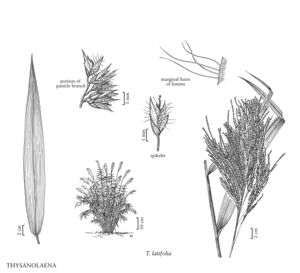Thysanolaena
| Taxon | Illustrator ⠉ | |
|---|---|---|
 | Thysanolaena latifolia | Hana Pazdírková Linda A. Vorobik |
Plants perennial; cespitose, shortly rhizomatous, reedlike. Culms 1.5-4 m, woody, persistent, glabrous, usually not branched above the base; internodes solid. Leaves cauline, distichous; sheaths open; auricles sometimes present; ligules membranous to somewhat leathery, entire, minutely erose, or ciliolate; pseudopetioles poorly developed; blades flat, disarticulating from the sheaths when old, cross venation not evident. Inflorescences terminal, open diffuse panicles. Spikelets solitary, pedicellate, terete, with 2 (3-4) florets, lowest floret in each spikelet sterile; rachilla extension prolonged, often terminating in a rudimentary floret; disarticulation at the pedicel bases, subsequently below the spikelets. Glumes membranous, shorter than the florets, 0-1-veined, obtuse; lowest florets equaling the upper florets, sterile; lowest lemmas membranous, 1-3-veined; lowest paleas not present; upper florets bisexual; upper lemmas membranous, 3-veined, unawned, marginal veins with papillose-based hairs, hairs 0.8-1.5 mm, strongly diverging at maturity; upper paleas about 1/2 as long as the lemmas, apices notched; lodicules 2, free, broadly cuneate, truncate to irregularly lobed; anthers 2 (3). Caryopses nearly spherical to broadly ovoid; embryos about 3/4 as long as the caryopses; hila subbasal, punctate, x = 12.
Discussion
Thysanolaena is a monotypic genus of tropical Asia, where it grows in open habitats, generally in mountainous areas. Its only species is grown as an ornamental in the Flora region.
Selected References
Lower Taxa
"decumbent" is not a number.